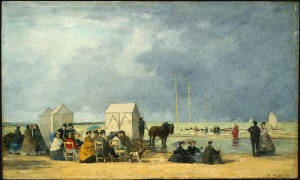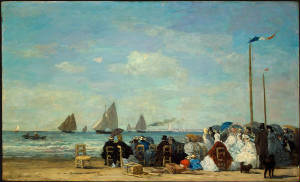
La Belle Époque (1871-1913)
SPREAD OF POWER WORLD WIDE
The hallmark of this era was the diffusion of power worldwide, away from France
and Britain and towards other Western states (Germany, Russia, Italy, the United States, Brazil, Argentina) and even to non-Western
Japan and Egypt. Although nationalists in France and Britain aroused hysteria by claiming that this power shift was evidence
of national decadence, in actual fact this was merely the product of these countries catching up to France and Britain. In
central Europe, the Americas, and points elsewhere, industrialization finally took hold. This increase in economic strength
was accompanied by rapid population growth in each of these industrializing countries even as French and British population
growth decelerated. To be sure, this shift away from France and Britain did not seriously challenge Franco-British prestige;
indeed, the rising new powers generally emulated French or British models of law, literature, and philosophy. Still, the rise
of these new powers forced tremendous change on the world, which quickly evolved into a decentralized complex of competing
world powers. Eventually, the strains became too much and the system collapsed in bloody war; in the interim, these strains
fostered an unparalleled fluorescence of culture and wealth known to posterity as la belle époque.
SPREAD OF POPULAR CULTURE
The worldwide spread of a common popular culture based on western European
-- in particular, French -- models had begun long before the 1870’s. It was only in this period, though, that advanced
communications and transportation technologies, the growth of mass literacy, and the emergence of a large middle class with
substantial purchasing power allowed for a truly rapid spread of a common culture. Influenced equally by the Romantics’
idealization of emotion and by the Enlightenment’s identification of humans as beings possessing innate capacities and
rights, many of the leading artists of the period pushed realism to its extreme limits. In literature, for instance, naturalist
writers such as the French Gustave Flaubert and Émile Zola and the English Thomas Hardy adopted a quasi-scientific attitude
in their writing about formerly taboo subjects such as sex, crime, extreme poverty, and corruption in officialdom, while the
Russian Fyodor Dostoyevsky, the Brazilian Paulo Carnheiro, and the Anglo-American Henry James explored the repressed psychological
motivations of human beings. Some authors -- like the French symbolist poets Verlaine and Rimbaud, the Norwegian dramatist
Ibsen, and the Anglo-Irish satirist Oscar Wilde -- even went out of their way to demonstrate their contempt for bourgeois
life or to shock complacent audiences in the hopes of awakening people to their everyday realities. Similar breaks with tradition
were present in music, whether in the form of Debussy’s atonal orchestral music, Stravinsky’s innovative classical
music, or the new popular musics emerging in the major cities of the Americas and France, inspired by non-European musical
styles and including once-taboo lyrics. In the graphic arts, impressionist and postimpressionist art -- the latter genre exemplified
by Cézanne -- defied long-cherished conventions of representation and showed a willingness to learn from primitive and non-European
art: Indeed, the French Gauguin was inspired by Tahitian life, while the Flemish Van Gogh was inspired by the hyperrealism
of japonaiserie, or Japanese prints. Other major styles included fauvism, in which artists such as Matisse exploited bold
color areas; cubism, as painted by the Spanish Picasso, which combined several views of an object on a single flat surface;
and futurism, pioneered by Italians, who tried to depict the energy of speed and motion. Architecture was marked by the exploration
of the uses of steel structures, using either neoclassical, curvilinear Art Nouveau, or functionally streamlined façades.
It is safe to say that throughout the West and in the most modern non-Western countries, this radical new popular culture
achieved near-universal penetration of urban populations and substantial influence elsewhere.
MASS MIGRATION OF PEOPLE
This rapid spread of a common global popular culture was remarkable in itself,
but this period’s mass migrations -- mainly from Europe, but also including some Asian emigrants -- was even more
spectacular, the 45 million international migrants over this period easily ranking as the single largest wave of migrants
in world history. The vast majority of these migrants emigrated to the rich republics of non-Andean South America and to the
self-governing British colonies in Australia and South Africa, but France (and France’s Algerian and South Pacific provinces)
also absorbed millions of immigrants over this period. Even North America absorbed tens of thousands of people annually. Prohibited
from entering these destinations by racist laws, most of the Asian emigrants -- overwhelmingly Indian and Chinese -- settled in Southeast Asia and some of the islands of the Caribbean
Sea and Indian Ocean under the auspices of colonial powers, taking advantage of their relative wealth and education to create
prosperous diasporas. These ceaseless migrations helped bind together many different countries by creating new hybrid identities
(like Italo-French, Germano-Australian, and Judeo-Brazilian) and by introducing elements of one culture to another (for instance,
the popularity of the Spanish Catalan sardana dance in southern France, brought by Catalan immigrants), though in places
it gave rise to violence.
GLOBAL ECONOMY
The creation of a unified global culture was parallelled by the creation of
a unified global economy, which was itself driven by this period’s rapid technological and organizational advances of
this period, and the rapid dispersion of these advances worldwide. In communications, a transatlantic telegraph network --
based on an 1844 invention by the American Morse -- linking the Americas with Europe and selected points in the Southern Hemisphere
had evolved by the end of the 1870’s, while British and American inventors independently happened upon the principles
behind the telephone in the late 1870’s. These startling advances were replicated in the realm of transportation as
railroads were rapidly expanded -- in the 1880’s, more than 150 thousand kilometres of railway were built in addition
to the 300 thousand kilometres already built, much of this length being built in the vastness of America, eastern Europe,
and Asia. Other advances came in the area of manufacturing, with the construction of more efficient machines and more efficient
processes. The human element was not neglected, as the perfection of the principles of mass production through the budding
science of sociology caused rapid increases in the per capita output of workers in industrializing countries. The economic
cooperative movement pioneered in the United Kingdom also enjoyed great popularity in the industrial world
among urbanites and peasants alike, as each group seized upon cooperatives as organizations that could allow them to enjoy
some economic autonomy from impersonal government and corporate bureaucracies.
TECHNOLOGICAL AND ORGANIZATION CHANGES
These immense technological and organizational changes, along with material
innovations like sewer systems, electric subways, parks, and bargain department stores, helped improve living standards for
many in the industrial world. They also made it essential for the world’s countries to modernize their economies using
these techniques else risk falling catastrophically behind. In fact, many of the events of this period were driven by technological
advances and the accompanying intense economic competition. The rapid spread of colonialism worldwide, for instance, was driven
by the demand for raw materials and new markets.
BRITISH EMPIRE
The United Kingdom, as the first industrial country of the world, remained
at the centre of the global economy. Britain remained a prosperous country, despite slow economic growth compared to France
or Germany; indeed, its slow population growth helped the rate of GNP per capita growth remain high even by European standards.
Furthermore, Britain enjoyed a cultural golden age, as evidenced by its acclaimed playwrights, prose writers, and musical
composers. The fact remained, though, that since the United Kingdom as a whole grew only slowly relative to its various competitors,
it came to increasingly depend upon the resources provided by its wider empire to remain abreast. The most visible example
of this was the large-scale recruitment of Indians as labourers and bureaucrats in the non-white areas of the Imperial; in
areas as diverse as Fiji, Guyana, Malaya, and Natal, the British crown sponsored the formation of Indian colonies of settlement. At the same time, though, the British Empire began to show signs of falling
apart. These included trends as various as the overwhelmingly non-British flood of European immigrants into the British colonies
of Australia and South Africa, the growing independence of Britain's colonies of settlement, the growth of
Indian nationalism, and the failure of Imperial trade protectionism in the last quarter of the 19th century and its replacement
with limited free trade with British allies. Perhaps the most significant proof of this to Europeans, though, was Britain's
dependence upon the entente cordiale signed in 1894 with France.
FRANCE
France, though humbled by the Franco-Prussian War, remained a dominant European state throughout this period. The quick replacement
of the unstable Third Republic by the much stabler Second Orleanist Kingdom gave France the political stability that it so desperately needed. After a brief
period of post-war economic recovery in the 1870's, France made a successful transition to stable liberal democracy and enjoyed
a period of considerable prosperity and cultural innovations. The city of Paris became the largest city in Europe in this
period, the cultural capital of Europe -- and indeed, the entire world -- and the centre of one of the largest industrial
districts in Europe.
 |
